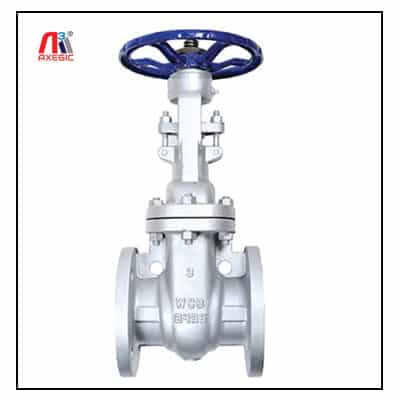One of the best Gate valve manuacturer, supplier, and exporter in Qatar
What is a Gate valve?
A gate valve is the most common valve for water supply systems. It is an isolation valve of linear motion and operates to prevent or permit the flow. The closure part that slides into the flow stream to produce shutdown and, as a result, acts like a gate, gives gate valves their name. When doing maintenance, repairs, new installations, or water pipeline rerouting, gate valves are utilised to isolate particular sections of the water supply network.
Design & parts of a gate valve
A gate valve is one of the most widely used valves in use today due to its simple construction and adaptability in applications with little pressure loss. Gate valves are created using full-port valves. This shows that the connecting pipe’s inner diameter and the valve port are of the same size. Full-bore gate valves do not lower pipeline pressure and allow the fluid to flow through without interruption. As a result, it is possible to clean the pipe using a cleaning pig.
A resilient seated gate valve with a non-rising spindle is made up of the following parts:
- wedge
- body of ductile iron valve
- a place to sit
- spindle
- The spindle bearing
- cowling
- wrapping
The gate valve’s body is its major component. It enables a cost-effective bonnet design since the spindle stays in the valve body while it is rotating. Because the valve bonnet is bolted to the body, cleaning and repair are possible. The wedge descends as the gate valve shuts and presses the valve seat, which would result in a complete shutoff. The wedge moves toward the upper portion of the valve body as it opens.
Over the past century, not much has changed in the construction of a wedge gate valve. The design of some few components of a gate valve has however changed somewhat. Most of the changes are carried out to prolong the life of the gate valve, improve sealing operation, as well as employing high quality materials and epoxy paint and coating to provide high corrosion resistance. Moreover, modern gate valve body is smooth and small in size, which allows to be installed in narrow spaces. In the past 70 years, gate valve models have already undergone seven generations of development.

Types of Gate valves
Gate valves for water supply systems can generally be classified into the following types based on construction:
- By wedge: wedge-shaped and parallel gate valves
- By seat: Gate valves with a robust seated or metal seat
- By stem: with a rising or flat stem.
Gate valves with parallel or wedge shapes
A flat, parallel-faced gate-like closing element is present in parallel slide gate valves and fits between two parallel seats. A sort of parallel gate valve is the so-called knife gate valve.
Due to the shape of the gate, wedge gate valves get their name. The slots in the gate valve body serve as guides for the wedge, which has ribs on both sides. The wedge guides’ functions are as follows:
- to pass to the valve body the axial loads that the medium imparts on the wedge
- to allow the wedge to travel in the radial direction with minimal friction
- to stop the wedge from rotating as it moves between the open and closed valve positions (serving as an anti-twist lock).
- Wedge gate valves are the most common type of gate valve utilised in water distribution systems.
Gate valves with a metal or robust seat
Wedge gate valves might have metal seats or strong seats. When a wedge is inserted into a groove in the gate valve body’s invert in metal seated gate valves, it typically traps any fluid particulates. Resilient seated gate valves are increasingly often used in water distribution systems because of their tighter shut-off.
A wedge, typically composed of ductile iron, is encased in resilient material (elastomer) in resilient seated gate valves, creating a tight seal. The wedge’s rim and the valve body are where the seating takes place. This eliminates the need for a groove at the valve’s base. In order to seal around tiny solids carried by the water flow, resilient seated gate valves are used.
All Axegic gate valves have durable seats, which are ideal for use in drinking water supply applications. The valve gate is vulcanised with premium elastomeric. For instance, the latest Axegic gate valve model E3 has a full elastomer coating on both the wedge and the nut, providing the best level of corrosion resistance. For any application, we provide a wide range of connectivity choices.
